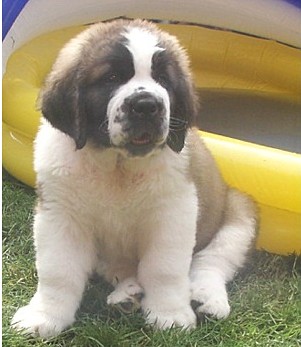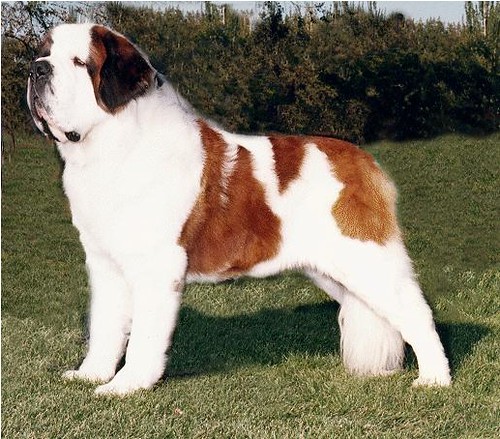
 Where to Rescue a Saint Bernard
Where to Rescue a Saint Bernard
The St. Bernard Dog is a very large breed of dog originally bred for rescue and as a working dog. A full-grown male can weigh between 100 and 200+ lb (45.35 / 91+ kg) and the approximate height is 27½ inches to 30½ inches (70 to 78 cm).
According to several resources they are one of the largest dog breeds. There are two varieties of the breed: the short-haired or smooth-coat variety and the long-haired or fluffy-coat variety.
Description
Appearance
| Saint Bernard Quick Facts | ||
|---|---|---|
| | ||
| Weight: | 100-199+ + lb | |
| Height: | 27.5-30.5 in | |
| Coat: | Smooth coat or Rough coat | |
| Activity level: | Medium | |
| Learning rate: | Medium | |
| Temperament: | friendly, loyal, loving | |
| Guard dog ability: | Medium | |
| Watch-dog ability: | High | |
| Litter size: | 2-14 | |
| Life span: | 9-11 years | |
Varieties
The St. Bernard originally was a smooth-coated dog developed to rescue travelers from the snow. In the 1830s the monks who owned and bred the dogs introduced Newfoundland blood to strengthen the breed, and this gave rise to the rough-coat St. Bernard. Although more popular[citation needed], the rough-coat variety proved to be unsuitable for mountain work because the long hair tended to collect icicles. For this reason the monks kept the smooth coat variety for rescue work.
Temperament
They are extremely gentle and friendly and very tolerant of children. The Saint Bernard is slow moving, patient, and obedient. Extremely loyal, this breed wants to please. Since this dog is so giant, be sure to socialize it very well at a young age with other people. It is highly intelligent and easy to train, however training should begin early, while the dog is still a manageable size. Bear in mind that an unruly dog of this size presents a problem for even a strong adult if it is to be exercised in public areas on a leash, so take control from the onset. The Saint Bernard is a good watchdog. Even its size is a good deterrent. They drool after they drink or eat.
Health
The very fast growth rate and the weight of a St. Bernard can lead to very serious deterioration of the bones if the dog does not get proper food and exercise. Many dogs are affected by hip dysplasia, elbow dysplasia. Osteosarcoma (bone cancer) has been shown to be hereditary in the breed
St. Bernards are susceptible to eye disorders called entropion and ectropion. The FCI standard indicates that this is now a major fault. The breed is also susceptible to epilepsy and seizures, a heart disease called dilated cardiomyopathy, and eczema.
The average life span of a St. Bernard is about 8 years,and some insurance companies will not issue a life insurance beyond 8 years.
In media
St. Bernards are often portrayed, especially in comics, cartoons and old live action comedies such as Swiss Miss, with small barrels of brandy worn around their necks. This was supposedly used to warm the victims that the dogs found. However, the monks deny that any St. Bernard has ever carried casks or small barrels around their necks; they believe that the origin of the image is an early painting. The monks did keep casks around for photographs by tourists.
One magazine cartoon showed a grown St. Bernard, presumably female, with several puppies; she and each puppy had a cask around the neck. The man with the dogs told a visitor, according to the caption, "Of course, I only breed them for the brandy."[citation needed]
History
The ancestors of the St. Bernard are the herding dogs of Swiss farmers like the Greater Swiss Mountain Dog, as well as hunting dogs and watchdogs. Their history has also been connected with the hospice at the Great St. Bernard Pass. First reports of the dogs' presence at the pass date to the 17th century, and they remained loyal companions to the monks there.
The most famous St. Bernard to save people at the pass was Barry (sometimes spelled Berry), who reportedly saved somewhere between 40 and 100 lives. There is a monument to Barry in the Cimetiere des Chiens, and his body was preserved in the Natural History Museum in Berne .
The classic St. Bernard looked very different from the St. Bernard of today, because an avalanche killed off many of the dogs used for breeding[citation needed]. To further the breed, they crossed the remaining dogs with other dogs, but in the process lost much of their use as rescue dogs. The St. Bernard is among the heaviest and largest dog breeds in the world. The heaviest and largest dog in known history was a Saint Bernard named Benedictine, which weighed 152.5kg (336 lbs). Successive studies suggest that Benedictine was in fact 162 kg (357 lbs). ).
Naming
The name "St. Bernard" originates from a travelers hospice on the often treacherous St. Bernard Pass in the Western Alps between Switzerland and Italy, where the name was passed to the local dogs. The pass, the lodge, and the dogs are named for Bernard of Menthon, the 11th century monk who established the station.
"St. Bernard" was in widespread use until the middle of the 19th century. The dogs were called "Saint Dogs","Noble Steeds", "Alpenmastiff", or "Barry Dogs" before, and in parts of North America, they're still called "Saints".
Movies
- In 1977, Wonderful World of Disney played a TV movie about St. Bernard rescue dogs, Barry of the Great St. Bernard.Part 2 was made in 1985.
- A St. Bernard is also the title dog of the 1992 film Beethoven and its sequels.
- Cujo is a 1983 film, based on the novel by Stephen King, about a rabid St. Bernard terrorizing a mother and child trapped in a broken-down car.
- A St. Bernard has a brief appearace near the end of 1969's On Her Majesty's Secret Service, where it comes to the aid of James Bond.
Famous St. Bernard
- Bolivar, Donald Duck's pet
- Unnamed St. Bernard whom Stan Laurel tricks of his keg of brandy in Swiss Miss
- Cujo, a fictional portrayal of a rabid St. Bernard
- Nanna, from various Peter Pan movies (but originally a Newfoundland in the text)
- Buck's father, from Jack London's The Call of the Wild
- Gumbo, team mascot for the New Orleans Saints
- Neil, the martini-slurping St. Bernard of George and Marion Kerby in Topper (TV series)
- Beethoven, the movie Beethoven
No comments:
Post a Comment